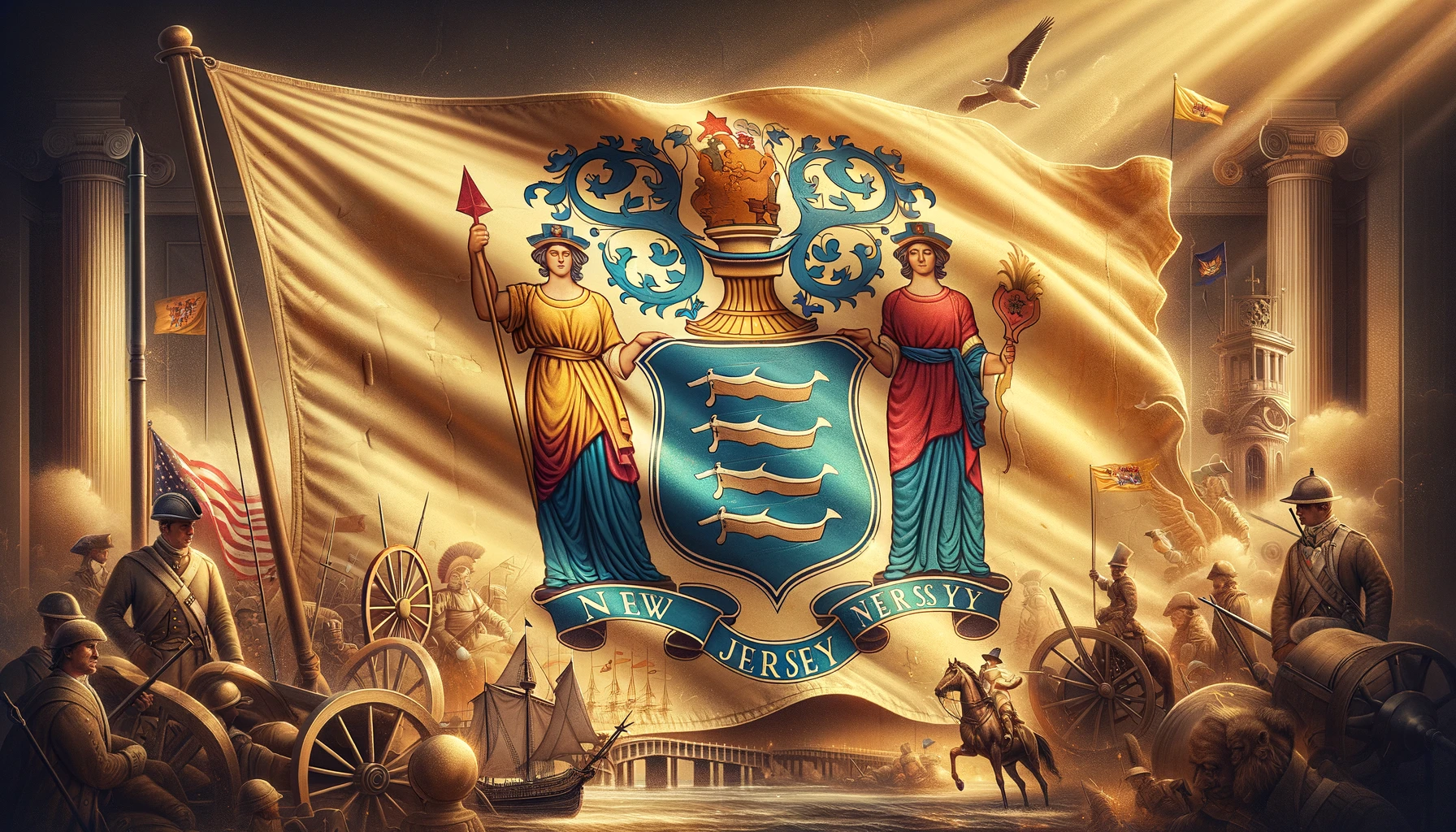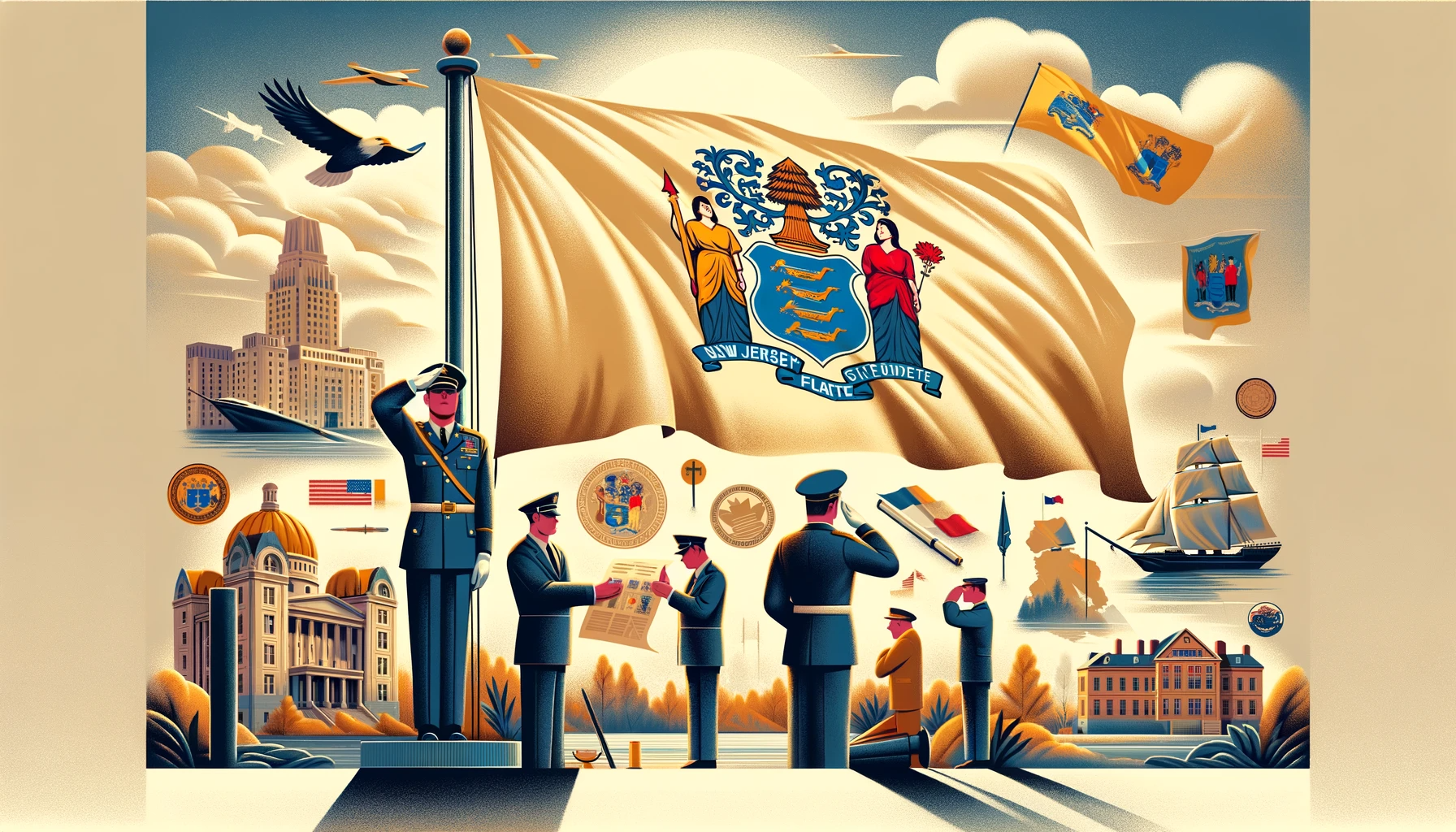The flag of New Jersey is one of the most distinctive and historical flags in the United States. It features a buff-colored background with the state coat of arms in the center, depicting a shield with three plows, a horse’s head, a helmet, and two female figures representing Liberty and Ceres. The flag also bears the state motto “Liberty and Prosperity” and the year of statehood “1776”.
But what is the history behind this unique flag? How did it come to be, and what does it symbolize? In this article, we will explore the origins, meaning, and symbolism of the New Jersey state flag, and why it is a source of pride for the Garden State.
Elements of the New Jersey State Flag |
|
|---|---|
Buff Background |
Chosen by George Washington, symbolizes:
|
Coat of Arms |
Designed by Pierre Eugene du Simitiere, reflects:
|
Motto & Year: |
“Liberty and Prosperity” (1776):
|

The Origins of the New Jersey State Flag
The Origins of the New Jersey State Flag
The New Jersey state flag has its roots in the Revolutionary War, when the state was one of the original 13 colonies that fought for independence from Great Britain. During the war, New Jersey played a crucial role in several battles, such as the Battle of Trenton, the Battle of Princeton, and the Battle of Monmouth. The state also hosted the Continental Congress in Princeton in 1783, where George Washington resigned as commander-in-chief of the Continental Army.
The flag’s design elements reflect the state’s military and agricultural heritage, as well as its sovereignty and dignity. The buff color of the flag was chosen by George Washington himself, who ordered that the uniforms of the New Jersey troops be dark blue with buff facings. Buff was a light tan color that resembled the color of undyed wool. Washington selected this color to honor the Dutch settlers who founded New Jersey, as buff was the color of the uniforms of the Dutch prince William of Orange. Buff was also a rare and expensive color at the time, indicating the state’s wealth and prestige.
The coat of arms of the state was designed by Pierre Eugene du Simitiere, a Swiss-born artist and patriot who also contributed to the design of the Great Seal of the United States. The coat of arms was adopted by the state legislature on October 3, 1776, and was based on the seal of Sir George Carteret, one of the original proprietors of New Jersey. The coat of arms features a shield with three plows, representing the state’s agricultural tradition and its nickname “The Garden State”. The shield is supported by two female figures: Liberty, holding a staff with a liberty cap, and Ceres, holding a cornucopia with fruits and grains. Liberty symbolizes the state’s freedom and independence, while Ceres symbolizes the state’s fertility and prosperity. Above the shield is a horse’s head, symbolizing speed and strength. The horse is also the state animal of New Jersey, and has played a vital role in the state’s economy and transportation. Below the shield is a scroll with the state motto “Liberty and Prosperity” and the year of statehood “1776”.
The Meaning and Symbolism of the New Jersey State Flag
The New Jersey state flag is a powerful symbol of the state’s history, culture, and values. It represents the state’s:
- Role in the Revolutionary War and the founding of the United States
- Legacy of the Dutch settlers and their influence on the state’s identity
- Importance of agriculture and industry in the state’s economy and development
- Pride and patriotism in the state’s achievements and contributions
- Respect and reverence for the state’s heritage and traditions
The flag also serves as a reminder of the state’s motto “Liberty and Prosperity”, which expresses the state’s aspirations and ideals. The motto reflects the state’s commitment to:
- Protecting and promoting the rights and freedoms of its citizens
- Fostering and supporting the growth and innovation of its businesses and industries
- Enhancing and enriching the quality and diversity of its communities and culture
- Preserving and conserving the beauty and resources of its environment and nature
The flag also inspires a sense of unity and solidarity among the people of New Jersey, who share a common history, identity, and vision. The flag is a symbol of pride for the Garden State, and a source of inspiration for its future.

The Meaning and Symbolism of the New Jersey State Flag
Conclusion
The New Jersey state flag is a unique and historical flag that reflects the state’s past, present, and future. It is a symbol of the state’s role in the American Revolution, its Dutch heritage, its agricultural and industrial achievements, and its motto of liberty and prosperity. It is also a symbol of the state’s pride and patriotism, its respect and reverence, and its unity and solidarity. The flag is a source of pride for the people of New Jersey, and a way to honor and celebrate the state’s history and values.


